Maria Massi
Max
Planck
Institut für Radioastronomie
Millimeter
and Submillimeter Astronomy Group 1. Curriculum
2. Teaching
Activity
1. Curriculum
2. Teaching
Activity
Lectures Winter term
Lectures Summer term
3. Scientific
Activity
Microquasars
Stellar Coronae
Physical mechanisms of
the radio continuum emission from
stars
Theory of the
very-long-baseline-radio-interferometry data
analysis
4. Public Outreach
Schülerpraktika
(Bonn,
Germany)
Monteprandone sotto le stelle (Monteprandone, Italy)
Conference:
"Steady Jets and Transient Jets"
Conference:
"Coronae of Stars and
Accretion Disks"
Curriculum
Personal record
Name: Maria Massi
Nationality: Italian
Marital status: Married, 2 Children
Education
Laurea
in Physics
University of Rome, Italy.
Ph.
D. in Astronomy
University of Bonn, Germany.
P.
Dozentin (Habilitation) in Astronomy University of
Bonn,
Germany.
Career
2001 - date
Teacher at the University of Bonn. Course I : Astrophysics of
Microquasars. Course II : Stellar Coronae
2000
- date Researcher at the Max Planck Institut
für
Radioastronomie (MPIfR , Bonn, Germany)
1997-1999
JIVE Support Scientist (Joint Institut for VLBI in Europe, Dwingeloo,
The Netherlands) at the MPIfR
1980-1996
Researcher at the Osservatorio Astrofisico di Arcetri
(Florence, Italy)
1979-1980
CNR Fellowship (Consiglio Nazionale delle Ricerche) at the
MPIfR, Bonn
1979
NATO Fellowship, University of Washington (Seattle,USA)
- Member
of the Scientific Organizing Committee for the Conference "Radio emission from
the Stars and the Sun." (Barcelona, 1995).
-
Member of the Technical and
Operations Group (TOG) for
the European VLBI Network (EVN): subgroup Operations(1998-1999).
-
Proposed for the"Marie
Curie Excellence Award" 2003-2004
of the European Union from Prof. G. Tofani (Director of the
Istituto
di Radio Astronomia, Bologna) and Prof. K. Menten (Director at
Max-Planck-Institut für
Radioastronomie, Bonn).
- Chair of the Scientific
Organizing Committee for the
Conference "Coronae of Stars and Accretion Disks" (Bonn, 2006).
The scientific activity
of Maria Massi developed in two distinct, but connected, areas:
on one part in astrophysics (i.e. microquasars, stellar coronae
and physical mechanisms of the
radio continuum emission from stars) and on the other in
astrophysical techniques (i.e. Radio-interferometry). The
results of the research in both fields have been published in
93
publications so distributed: 40 articles in refereed journals,
15
technical reports, 38 proceedings.
Articles
in refereed Journals
Articles
in Conference Proceedings
Technical
Reports
Teaching
Activity
I. Quasars and Microquasars
6951
Quasars and Microquasars
Thursday 13-15,
HS 0.01, MPIfR
Instructor: Maria Massi
Stellar-mass black holes in our Galaxy mimic many of the
phenomena seen in quasars but at much shorter timescales.
In these lectures we present and discuss how the simultaneous use of
multiwavelength observations has allowed a major progress in the
understanding of the accretion/ejection phenomenology.
Chapter 1
Microquasars and
Quasars
Definitions
Stellar evolution, white dwarf, neutron star, BH
Chapter 2
Accretion power in astrophysics
Eddington luminosity
Temperature of the accretion disc
Low and High Mass X-ray Binaries
Accretion by wind or/and by Roche lobe overflow
Mass function: neutron star or black hole?
Chapter 3
X-ray observations
Spectral states
Quasi Periodic Oscillations (QPO)
Chapter 4
Radio observations
Single dish monitoring and VLBI
Superluminal motion (
review,
article)
Doppler Boosting
Synchrotron radiation
Plasmoids and steady jet
Chapter 5
AGN-1
AGN-2
AGN-3
AGN-4
Summary
II. Stellar and Solar Coronae
6945
Stellar and Solar Coronae
Thursday 13-15,
HS 0.01, MPIfR
Instructor: Maria Massi
T Tauri (young stellar systems not yet in Main Sequence) and RS
CVn systems (evolved stellar systems that already left the Main
Sequence), although very diverse systems, have similar flare activities
observed at radio and X-ray wavelengths.
The flares in both systems are several orders of magnitude stronger
than those of the Sun. The origin of this activity, defined
"coronal activity", depends on the convective zone, the rotation, the
formation and dissipation of magnetic fields. In general terms: This is
a mechanism of the same type as on the Sun, but enforced by the binary
nature of these systems.
In these lectures we will explore a link between the amplification of
initial magnetic fields by dynamo action in several rotating systems (
Sun, binary systems and accretion discs around black holes) and the
release of magnetic energy into a corona where particles are
accelerated.
Together with the basic theory there will be as well illustrated
the latest progress in the research on stellar coronal emission derived
from recent space missions and high-resolution radio observations.
Solar
Cycle: Observations
Solar
Cycle: Theory
Flare theory
The standard model of the solar flares
Physical Processes
Stellar Coronae
Summary
Scientific
Activity
Microquasars are stellar binaries, where a
collapsed object (black hole or neutron star) accretes material from a
normal star. As compared with a quasar (with black holes up to
10^9 solar masses) the microquasar's
black hole (of a few solar masses) is surrounded by a smaller (of 9
order of magnitude) accretion disk and produces a smaller jet,
yet relativistic. Several phenomena relative to the accretion
process in quasars, occur as well in a microquasar, but at much shorter
time scale (hours/days instead of years).
That explains the big interest attributed recently to these objects.
The microquasars are a selected
class of the X-ray binaries.That are systems well
known since the 1960s: the X-ray emission originates from the
very hot accretion disk surrounding the compact object.
However, it took a long time to discover that some of these
systems also have relativistic radio jets. For several
years, after its discovery on 1979, SS 433 with its
spectacular jets was thought to be a unique case.
After the discovery of a second source ( Cyg X-3)
several groups (including us) in the 1990s started to search for new
X-ray binaries with radio emitting jets.
LS I +61
303
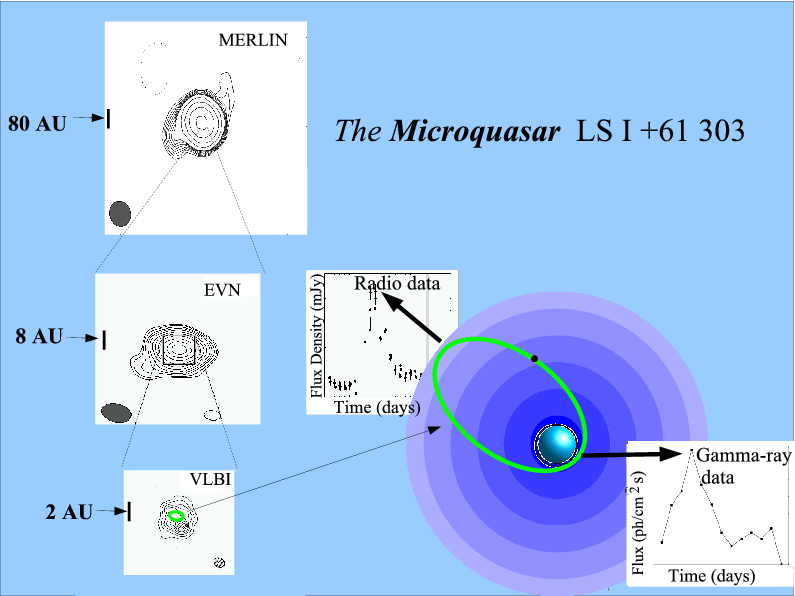 Fig. 1
Fig. 1
LS I +61303 is one of the most observed
Be/X-ray
binary systems because, peculiarly, it has periodical radio
and X-ray emission together with strong, variable gamma-ray
emission.
The binary stellar system has an orbital period of 26.496 days and a
rather eccentric orbit
(e=0.7). The visible
companion is an early type, rapidly rotating B0Ve
star. Be stars have a dense and slow disk-like wind with a wind
density distribution following a power law. Through this dense,
structured and variable envelope the compact object (black dot on
the orbit in Fig. 1)
travels and
accretes.
The accretion rate in an eccentric orbit has two peaks: One
peak
corresponds to the periastron passage because of the highest density;
the second peak occurs around apastron where the drop in
the relative velocity of the compact object compensates the
decrease in density. For supercritical accretion, theory predicts
matter be ejected outwards in two jets perpendicular to the
accretion disk plane. However, near periastron the ejected
relativistic electrons are embedded in such a strong UV-radiation
field that they loose completely their energy by inverse
Compton process (gamma-ray emission is observed but
no radio emission). During the second accretion peak, the compact
object is much farther away from the Be star and both, inverse
Compton losses and wind opacity, are lower: The electrons can propagate
out of the orbital plane and radio outbursts are
observed.The radio emission has been resolved with VLBI, EVN and MERLIN
observations and in agreement with the theoretical predictions the
image shows bipolar jets emerging from a central core (see
articles 18,21,24,27,32,36,37,39; conf. proc.
12,15,19,27,31,33,35,36,38)
LS 5039
Most of the known
microquasars were discovered after a noticeable X-ray
outburst (observed by satellites) that triggered the detection
of the radio-jet with ground based telescopes. Our
procedure, led by Paredes of the University of Barcelona,was
different. We performed high resolution radio observations
(VLBA)
of a selected sample of sources determined by a
systematic cross-correlation between public archives of data
in the X-ray, radio and optical domains under restrictive selection
criteria.
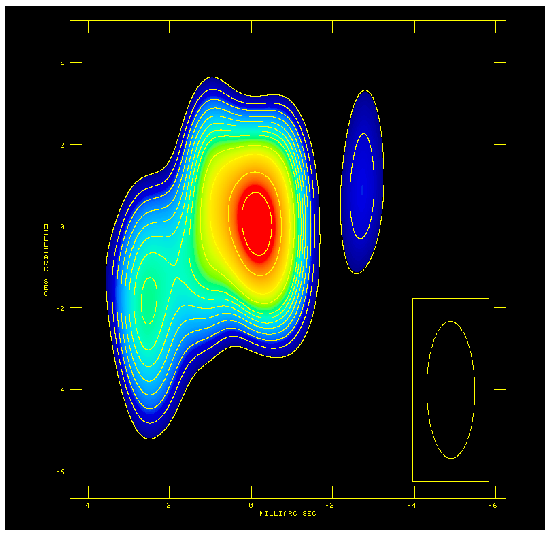 The VLBA
map of the resulting candidate LS 5039 proves that the
radio
structure is that of bipolar jets
emanating
from a central core. The presence of radio jets in this X-ray
binary
is the main evidence of an accretion process resulting in the ejection
of relativistic particles. The
overall
length of the source is about 18 AU. The stronger jet is interpreted as
an approaching Doppler-boosted jet of a symmetric pair. Almost
simultaneously with that observation, the
publication of the third EGRET catalog (Hartman et al. 1999) allowed us
to search for a possible counterpart at
higher energies: As a result we found a coincidence of LS5039 with the
gamma-ray source 3EGJ1824-1514. (articles 31, 34, 35; conf. proc.
20,21,22,23,25,26,28, 29,30,34)
The VLBA
map of the resulting candidate LS 5039 proves that the
radio
structure is that of bipolar jets
emanating
from a central core. The presence of radio jets in this X-ray
binary
is the main evidence of an accretion process resulting in the ejection
of relativistic particles. The
overall
length of the source is about 18 AU. The stronger jet is interpreted as
an approaching Doppler-boosted jet of a symmetric pair. Almost
simultaneously with that observation, the
publication of the third EGRET catalog (Hartman et al. 1999) allowed us
to search for a possible counterpart at
higher energies: As a result we found a coincidence of LS5039 with the
gamma-ray source 3EGJ1824-1514. (articles 31, 34, 35; conf. proc.
20,21,22,23,25,26,28, 29,30,34)
II.
Stellar Coronae 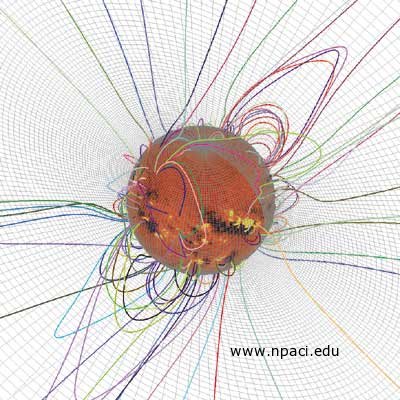
Magnetic configuration and
mechanisms of stellar flares
The dynamo
theory (Parker
1955) explains how differential rotation generates a toroidal
field in the interior of a star from an initial
stellar dipole field, and how convection, bringing up this
field to the surface, creates the coronal magnetic arc-like
structures called loops. Whereas the Sun's
global dipolar field is of only a few gauss the loops are
"islands" of enhanced magnetic fields reaching at their
photospheric footpoints (sunspots) thousands of gauss.
There exists a close
relationship between magnetic loops
and flares. In fact, as observed on the
Sun, flares are triggered
by interactions between new and older emergences of magnetic flux in
the same area (Nishio et al. 1997). The
released magnetic energy accelerates a part of the
thermal electrons trapped in the loops to high energies causing the
flare (Priest & Forbes 2002).
RS
CVn and T Tauri systems are characterized by
intense (orders of
magnitude higher than the Sun) coronal activity at X-rays, UV and radio
wavelengths. Long time
monitorings of the radio
flux
density of RS CVn and
TTauri
systems, performed with the Effelsberg 100-m telescope, have shown the presence of periodicities in the flaring
activity of UX
Arietis and
V773
Tauri (articles 19,
25, 33,38).
This
observational finding has opened the question if the
periodicities
could be due to an inter
binary collision (therefore depending on the
binary
nature of UX Arietis and V773 Tauri) or instead due to an
intrinsic
mechanism originating in the stellar interior (and therefore
also
common
to other stars).
UX Arietis
The process causing
the emerging of the loops is the dynamo working in the star's interior.
However, Rossby-type waves might modulate the
emergence of magnetic flux (Lou 2000). In this respect , periodic emergence
of magnetic flux through the
photosphere may operate in two different ways, either forming spots
within already established
active regions (and therefore inducing
periodic flares by
magnetic reconnection) or by forming new spots away from
active regions(Ballester
et al. 1999) .
The Rieger periods are solar
cycles with a time
scale of
months,
which are present in
both flaring activity and
sunspot occurrence.
These short-term periodicities are considered a peculiar and
not yet
fully understood solar phenomenon (Ballester, Oliver
and
Carbonell 2002).
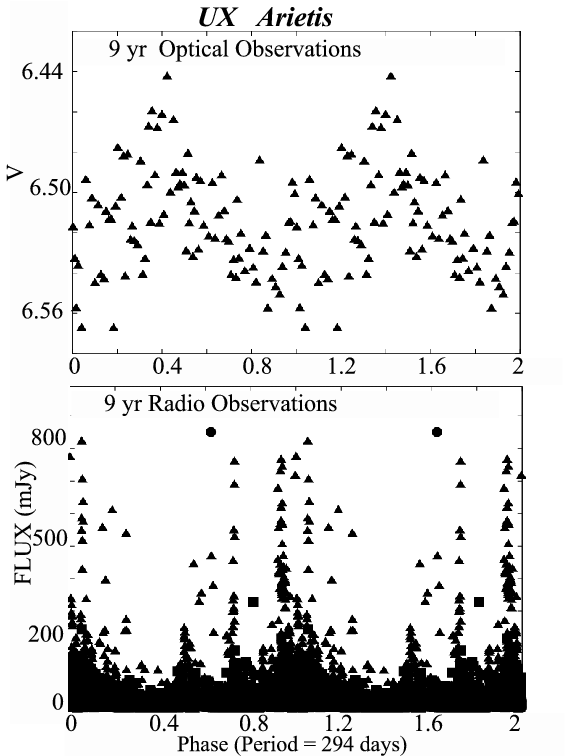 We performed a timing analysis
of two 9-year datasets of radio and optical observations of UX
Arietis (art. 38). The analysis
reveals a 294-day cycle. When the two 9-year datasets are
folded with this period, synchronization of the peak of the optical
light curve (i.e., the minimum spot coverage) with the
minimum radio flaring activity is observed (Fig. 2). This
close relationship between two completly independent curves makes
it very likely that the 294-day cycle is real. We conclude
that the process invoked for the Sun of a periodical emergence
of magnetic flux may also be applied to UX Arietis and can
explain the cyclic flaring activity triggered by interactions
between successive cyclic emergences of magnetic flux in the same
area.
We performed a timing analysis
of two 9-year datasets of radio and optical observations of UX
Arietis (art. 38). The analysis
reveals a 294-day cycle. When the two 9-year datasets are
folded with this period, synchronization of the peak of the optical
light curve (i.e., the minimum spot coverage) with the
minimum radio flaring activity is observed (Fig. 2). This
close relationship between two completly independent curves makes
it very likely that the 294-day cycle is real. We conclude
that the process invoked for the Sun of a periodical emergence
of magnetic flux may also be applied to UX Arietis and can
explain the cyclic flaring activity triggered by interactions
between successive cyclic emergences of magnetic flux in the same
area.
Fig 2. UX Arietis
Folding of the radio and
photometric V
data with a period of 294 days.
Bottom: Folding of the radio data with a
period
of 294 days.The phase interval 0--1 is repeated twice.There is a clear
lack of energetic flares at phase 0.4. Top: Folding of the photometric
V data with the same period of 294 days, as the radio data. The data
are averaged over phase bins of 0.01. The peak for V at phase
0.4 corresponds to a minimum in spot coverage and is well
synchronized with the ``hole'' of radio flaring activity.
V773 Tauri
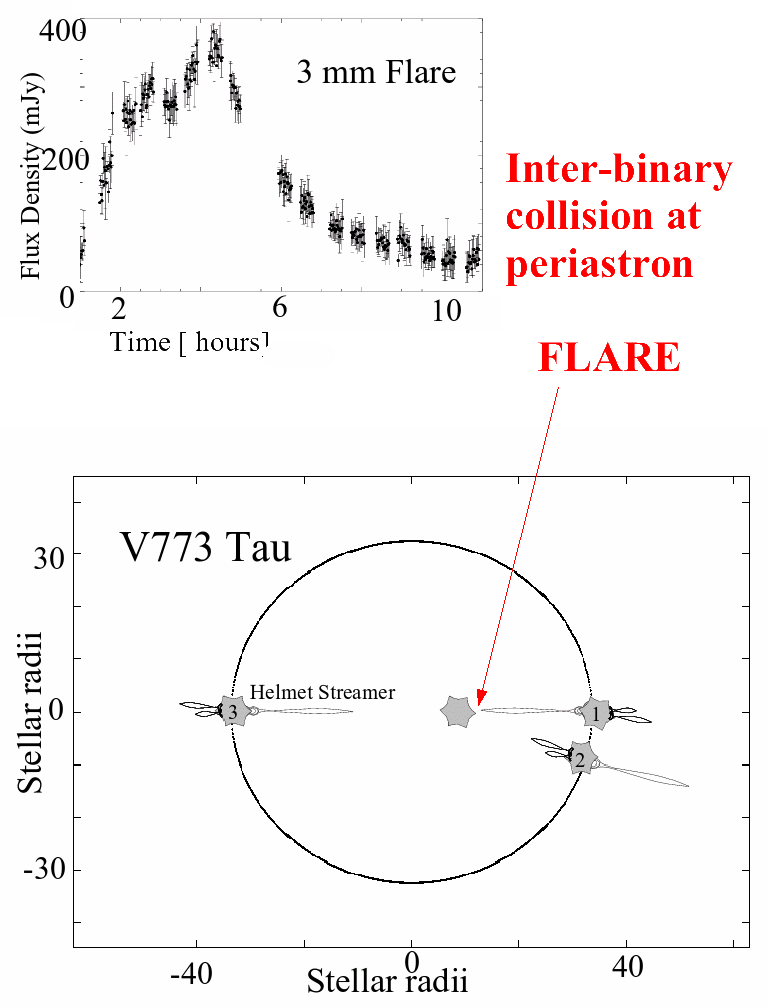 Fig. 3.
V773 Tauri
Fig. 3.
V773 Tauri
Top: Flare observed at
periastron passage with the PdBI.
Bottom: sketch
of the binary system.
The system V773 Tau is composed of two stars orbiting with a
period of 51.075 days. In the
sketch of Fig. 3 one star is plotted in the focus
of the slightly eccentric orbit, the other star is shown at three
different positions along the orbit.
A periodicity in the radio flaring
activity, evident during the Effelsberg 100-m telescope
monitoring, was
confirmed by a dominant peak at 52 \pm 5 days in the
Fourier
power spectrum. Folding the data with the orbital period of
51.075 days the flares
cluster at the periastron passage. The detailed monitoring around
one periastron passage with the VLA and with the Effelsberg
telescope reveals a modulation of the radio emission in
agreement with the 3.4 days rotational period of the star spots,
observed in the optical range. A possible scenario explains the
52 days periodicity and the 3.4 days modulation with
recurrent interactions of giant magnetic structures, anchored on
the two rotating stars of the system, consecutively
colliding for two or three rotations during each periastron
passage (art. 33).
We have observed such a flare at a
wavelength of 3 mm (art. 40). We rule out that the fast fading of
the emission can be due to energetic losses (i.e.
synchrotron, collisional and inverse Compton losses) of the emitting
electrons and propose that it is
due to the leakage of the emitting electrons themselves at each
reflection between the
two mirror points of the magnetic structure partially trapping
them. The magnetic structure compatible with the leakage
model is that of an
helmet streamer that, as in the solar case, may occur at the top
of
X-ray emitting stellar-sized coronal loops of one of the stars.
Interpreting the rising time of the flare of Fig. 3 in
terms of propagation towards the low corona of a shock due to a
magnetic reconnection event occurring at large height, we have
determined a height compatible with periastron distance.
Therefore, the
streamer may interact
with the corona of the other star at periastron passage, causing
recurring flares.The inferred magnetic field strength at the two
mirror points of the helmet streamer is in the range 0.12 - 125 G and
the corresponding Lorenz factor of the partially
trapped electrons results to be 20 < gamma < 632. We
therefore rule out that the emission could be of
gyro-synchrotron nature: the derived high Lorenz factor
proves that the nature of the emission at 90 GHz from this
pre-main binary system is synchrotron radiation.
III.
Physical mechanisms
of the radio continuum emission from stars
Investigations on the conditions which produce
continuum
radio emission from the stars, and on the characteristics of the
emission
(thermal and non thermal) have been performed. The study includes not
only
"normal" stars (i.e. appearing in the classical Hertzsprung -
Russel
diagram) of early and late type, but also pre-main sequence stars
and compact objects (as neutron stars and black holes).
Ionized envelopes around stars of early
spectral
types, winds and ultra compact HII regions, have been
investigated,
and the specific differences of the two types of emission (i.e.
different
spectral index, different density distributions, etc.) have been
analysed
(see articles 2,3,4). In the star forming region M17 beside
winds
and
ultra compact HII regions other sources have been identified, which
suggest
to be neutral clumps surrounded by ionized (from external
stars)
envelopes (art.
5). This suggestion has been proved by a later
observation
in the (1,1) ammonia line (art. 8). Other sources in the core of the
Orion
nebula having thermal spectra as well but not fitting any of the above
models are explained as protostellar disks,
of
optically visible low mass stars, ionized by external stars
(art. 7). In conclusion the basis of the radio continuum emission of
all
these type of sources, beside specific differences, is the same
physical
mechanism: The radio emission is due to electrons with a
Maxwellian
velocity distribution, deflected in the coulomb fields of ions (i.e.
free free).
Depending on the presence and strength of a
magnetic
field, accelerations due to encounters of electrons with ions can
become
negligible in comparison with those due to gyration around the field
lines.
Trapped in the magnetic loops of stellar systems, electrons with
Maxwellian distributions are able to produce gyro
synchrotron
radiation. However, often the characteristics of the spectra
cannot be fitted with a Maxwellian distribution
because this would imply too strong magnetic fields (papers 11,
17).
For realistic values of B this corresponds to the case of
enough
high energetic electrons with rare collisions; in this case a
non-Maxwellian
tail is dominant and the distribution is described by a power law
(art. 9, 26). In the case of mildly relativistic particles we
observe
gyro synchrotron radiation, while for high relativistic particles
the observed emission is synchrotron.
Which physical
processes
are able to accelerate the electrons to high energy ?
Electrons can be accelerated to quasi
relativistic
energies by magnetic reconnection in binary
systems
of RS CVn type; this occurs if two fields of opposite directions
are pushed one against the other as in the case of emerging loops
intruding from below the stellar surface into other loops already
established.
In one of the most active RS CVn systems, UX Arietis, high
resolution
radio measurements (by VLBI techniques) have been fitted with
models
of intruding loops (art. 28, 29; conf. proc. 32). The process causing
the emerging of the loops is the dynamo working in the star's interior.
At the best this can be studied by long time monitoring of the
flux
density; that is the reason for the monitoring program of RS CVn and
TTauri
stars with the Effelsberg 100-m telescope art. 19, 25, 33). We
note that the first
class
include late type stars, while the TTauri are pre-main
sequence
stars. The common characteristic of the two classes of stellar
systems
is the presence of a deep convective zone in both: the main ingredient
for the dynamo to work. Periodicities have been
discovered
in UX Arietis and the TTauri system V773 Tau (art. 25,33 and 38).
This observational finding has opened the question if the
periodicities
could be due to an inter binary collision (therefore depending on the
binary
nature of UX Arietis and V773 Tau) or instead due to an
intrinsic
mechanism originating in the stellar interior (and therefore also
common
to other stars).
Other mechanisms of electron acceleration
are by means of
collisions between the winds of the components
of a binary system, as proposed for the WR star HD 193793
(art. 15, 16; conf. proc. 8) or by means of super
accretion processes around
compact objects as neutron stars or black holes, accreting from a
normal
companion. In this last class of objects, called microquasars,
the morphology of the radio emission is that of a double relativistic
jet
(orthogonal to the accretion disk of the compact object) as
in LS I 61303 and LS 5039 (see sec. I).
IV.
Theory
of the Very-Long-Baseline-Interferometry data analysis.
The lack of phase information had prevented VLBI
from
being a true imaging technique until Rogers and his co-workers (1974)
applied
a phase closure relationship. The introduction of the closure phase
concept marks the beginning of a new era in VLBI. Many authors
developed
methods, reviewed by Pearson and Readhead (1984),
which
explicitly or implicitly use this quantity. In paper 10 I show
how
the methods explicitly using the closure phase can be unified in
one equation. In one attempt to unify all methods together we have
found
that all methods turn out to be particular cases of the
method
proposed by Schwab (1980) depending on a proper scheme of
baseline
weighing (art. 12).
By using Schwab's method,
called
self-calibration,a
map of the radio source can be obtained by using an algorithm
which
includes fourier transform and CLEAN, following an
iterative
procedure first indicated by Readhead and Wilkinson (1978) and called Hybrid
mapping. That this procedure can converge on wrong solutions has
been
pointed out by many authors in the past: Walker (1986) indicated the
bias
in the resultant data due to the use of a point source as starting
model.
Baath (1989) suggested the use of the original data set in each
iteration
of self calibration. Linfield (1986) analysed the role of the (u-v)
coverage
and lack of intermediate spacing. Generally, the full procedure
to
avoid false features is not clear and only experience with
imaging
helps the user to avoid them.
In paper 30 we have demonstrated
that
the problem is connected with the non-linear nature of self calibration
which leaves initial wrong assumptions frozen in the final solution. We
demonstrated that the general precondition to avoid false structures in
the map is that the errors (or more precisely their cube) of the model
should be smaller than the observed closure phases. This
condition,
generally satisfied for a standard earth based array, is violated
if one telescope of the array is very displaced from the others,
as it is for an array including one telescope mounted on a satellite.
Using self calibration it is assumed
that
the baseline based errors are negligible. In spite of the fact that
these
baseline errors are quite small their effect on the map's quality is
rather
serious. Tests were performed to determine at which level errors
limit
the obtainable dynamic range with the VLA (Perley 1986)
and
with the VLBA (Briggs et al. 1994).
For the European VLBI Network (EVN)
such an analysis has been developed by myself and my
collaborators
(art. 22, 23; conf. proc. 6,7; tech. reports 10, 11, 14).
The result of our analysis was that the cause of the low
dynamic
range of the EVN maps was the large instrumental
polarization
("D" terms) at many European telescopes. The correction of
the
D terms has been always disregarded in the past because
they
were assumed to be negligible and because they affect
the data at the second order only. On the contrary, our analysis
and monitoring have shown that: 1) the instrumental polarization is
quite
large (up to 20%) and presents an unexpected strong frequency
dependence (see Fig. 1),
2) its removal led to an improvement in the dynamical range of
the
images up to a factor 7.
As a result of this work the international software
AIPS
released at Socorro (USA) has been changed to apply this
correction.
The updated versions of AIPS to use are those with release 15OCT96 and
later.
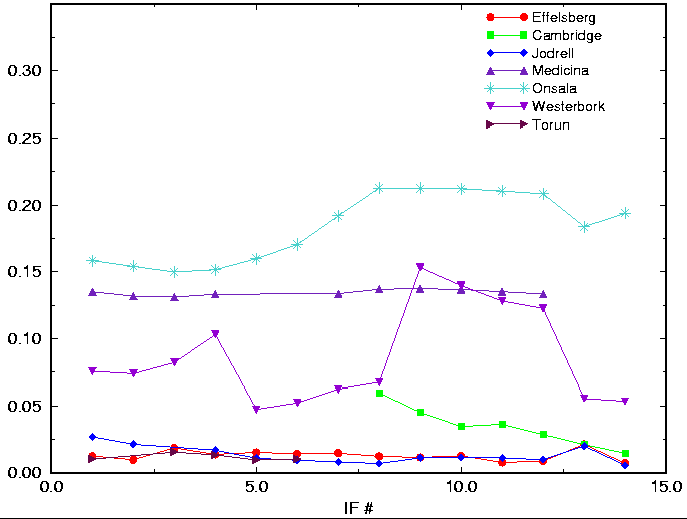
Fig. 1: Plots of the left D-term amplitude (1=100%) for various EVN
telescopes (6cm network monitoring experiment C-1997-C1A) as a
function of frequency. The symbols are described in
the plot legend (see Massi & Aaron EVN-Doc 77)
Monteprandone
sotto le Stelle
Maria Massi, Jürgen
Neidhöfer, Egidio Zennaro, Eulalia Romandini
in
collaborazione con la locale Associazione PRO LOCO
 Conferenze
Astronomiche e Osservazione col Telescopio
Conferenze
Astronomiche e Osservazione col Telescopio
Monteprandone
Conferenza (ore
21:00)
Osservazione astronomica (ore
22:30)
1.
Il sistema solare (29
Dicembre 2002)
2.
La nostra Galassia (6 Settembre 2003)
3.
Il Big-Bang (12 Aprile 2004)
4.
Buchi neri e Quasar (17
Aprile 2006)
5.
Come nascono le stelle ?
(Agosto 2007)
6.
Microcosmo macrocosmo
(22 Luglio 2008)
7. Dal Big-Bang all'uomo (1 Agosto 2009)
8.
Stelle cadenti (11 Agosto 2010)
9. Dal sistema solare ai confini dell'Universo (
24 Luglio 2011) 
Articles
in Refereed Journals
40)"Synchrotron
emission
from the T Tauri binary system V773 Tau A"
M. Massi, J. Forbrich,K. M. Menten, G.
Torricelli-Ciamponi , J. Neidhöfer,S. Leurini and F. Bertoldi
2006, AA,
accepted
39)"Introduction to
Astrophysics of Microquasars"
M. Massi.
Habilitation Thesis, June 2005,
University of Bonn, Germany 2005, astro-ph/0506731
38)"Discovery of Solar Rieger periodicities in another
star"
M. Massi, J.
Neidhöfer, Y.
Carpentier and E. Ros
2005, AA, 435, L1
37)"LS I +61°303 in the context of microquasars"
Massi, M.
2004, AA, 422, 267
36)"Hints for a fast precessing relativistic radio jet in LS I
+61°303"
Massi, M., Ribó, M.,
Paredes, J. M., Garrington, S. T., Peracaula, M. and Martí, J.
2004, AA, 414, L1
35)" EVN and MERLIN observations of microquasar candidates at
low galactic latitudes "
M. Ribó, E. Ros, M. Paredes,
M. Massi, J. Martí
A&A, 394, 983 (2002)
34)"Confirmation of persistent radio jets in the microquasar
LS 5039"
J. M. Paredes, M. Ribó, E. Ros, J.
Martí,
M. Massi
A&A Letter, 393, 99 (2002)
33)"Periodic radio flaring on the T Tauri star V773 Tauri"
M. Massi, K. Menten, J. Neidhöfer
A&A, 382, 152 (2002)
32)"One-sided jet at milliarcsecond scales in LS I +61303"
M. Massi, M. Ribo, J. M. Paredes, M. Peracaula, R. Estalella
A&A , 376, 217 (2001)
31)"Discovery of a high-energy gamma-ray-emitting persistent
microquasar"
J. M. Paredes, J. Martí, M. Ribó, M. Massi
Science, 288, 2340 (2000)
30)"Space VLBI and Spurious Symmetrization"
M. Massi, S. Aaron
A&A Suppl. Ser., 136, 211 (1999)
29)"Flaring loop structures at VLBI scale in UX Arietis"
E. Franciosini, M. Massi, J.M. Paredes, R. Estalella
A&A, 341, 595 (1999 )
28)"Investigation of stellar loop structures using VLBI"
M. Massi, E. Franciosini, J.M. Paredes, R. Estalella
New Astronomy Reviews, 43, 539 (1999)
27)"Milliarcsecond radio structure of LSI+61 303"
J. M. Paredes, M. Massi, Estalella R., M. Peracaula
A&A, 329, 951 (1998)
26)"Radio flares from the active binary system UX Arietis"
G. Torricelli, E. Franciosini, M. Massi, J. Neidhöfer
A&A, 333, 970 (1998)
25)"Activity Cycles in UX Arietis"
M. Massi, J. Neidhöfer, G. Torricelli-Ciamponi, F.
Chiuderi-Drago
A&A, 332,14 (1998)
24)"Deep VLA images of LSI+61303: a search for associated extended
radio emission "
J. Marti , M. Peracaula ,J.M. Paredes , M. Massi ,R. Estalella
A&A, 329, 951 (1998)
23)"Baseline errors in European VLBI Network measurements III.
M. Massi, M. Rioja, D. Gabuzda, K. Leppanen, H.
Sanghera, K. Ruf, L. Moscadelli
A&A, 318, L32 (1997)
22)"Baseline errors on European VLBI Network measurements II.
Instrumental
Polarization"
M. Massi, G. Comoretto, M. Rioja, G. Tofani
A&A Suppl., 116, 167 (1996)
21)"A search for near-infrared variability in LSI+61303"
L. K. Hunt , M. Massi ,S. A. Zhekov
A&A, 290, 428 (1994)
20)"Critical density for magnetic decoupling: preliminary
observations"
M. Massi , S. Lizano
A&A, 287, 581 (1994)
19)"Periodicities in the Radio Emission of UX Arietis ?"
J. Neidhöfer , M. Massi , F. Drago
A&A, 278, L51, (1993)
18)"High resolution radio map of the X-ray binary LSI+61303"
M. Massi , J. M. Paredes , R. Estalella , M. Felli
A&A, 269, 249 (1993)
17)"Quiescent Radio Emission in UX Arietis"
M. Massi, F. Chiuderi-Drago.
A&A, 253, 403 (1991)
16)"Intercontinental VLBI observations of theta 1 Orionis A"
M. Felli, M. Massi, M. Catarzi.
A&A, 248,453 (1991)
15)"VLBI observations of HD 193793"
M. Felli, M. Massi
A&A, 246, 503 (1991)
14)"Baseline errors in VLBI measurements"
M. Massi, G. Tofani, G. Comoretto.
A&A, 251, 732 (1991)
13)"The H2O maser Arcetri atlas".
G. Comoretto, F. Palagi, R. Cesaroni, M. Felli, A. Bettarini, M.
Catarzi,G. P. Curioni, S. Di Franco, C. Giovanardi, M. Massi, F. Palla,
D. Panella, E. Rossi, N. Speroni, G. Tofani.
A&A. Suppl. Series, 84, 179 (1990)
12)"Recovery of phase information from radio-interferometric
observations".
M. Massi, G. Comoretto.
A&A, 228, 569 (1990)
11)"High resolution radio observations of theta 1 Orionis
A"
M. Felli, M. Massi, E. Churchwell.
A&A, 217, 179 (1989)
10)"Application of Lagrangian multipliers in hybrid mapping "
M. Massi
A&A, 208, 392 (1989)
9)``VLBI observations of RS CVn and Algol-type binaries."
M. Massi, M.Felli, R. Pallavicini,F. Palagi, G. Tofani, M. Catarzi.
A&A,197, 200 (1988)
8)"Small scale clumping in M17"
M. Massi, E. Churchwell, M. Felli
A&A, 194, 116 (1988)
7)"Solar system sized condensations in the Orion Nebula"
E. Churchwell, M. Felli, D Wood, M. Massi
ApJ, 321, 516 (1987)
6)"Radio continuum observations of the blister type HII region
in MonR2"
M. Massi , M. Felli, M. Simon
A&A, 152, 387 (1985)
5)"A high resolution study of M17 at 1.3, 2, 6 and 21 cm"
M.Felli, E.Churchwell, M. Massi
A&A, 136, 53 (1984)
4)"High spatial resolution observations of S106 from 0.6 micron
to 1.3 cm. A wind model for the bipolar nebula"
M.Felli, J.Staude,Th. Reddmann,M. Massi, C. Eiroa, H. Hefele,Th.
Neckel and N. Panagia
A&A, 135, 261 (1984)
3)"Star formation in the M8E region"
M. Simon, L. Cassar, M. Felli, J. Fischer, M. Massi, D. Sanders
ApJ, 278, 170 (1984)44
2)"Infrared line and radio continuum emission of circumstellar
ionized
envelopes"
M.Simon, M.Felli, L.Cassar, J.Fischer, M. Massi
ApJ, 266, 623 (1983)
1)"Long-baseline interferometry of compact radio sources at
18 cm"
L. Matvejnko, B. Kostenko, A. Papaczenko, N. Bartel, M. Massi, J.
Romney,K.Weiler,A. Ficarra, F. Mantovani,L. Padrielli, I. Moiseev, L.
Both,T.
Nicolson
Soviet Astronomy Lett., 7, 259 (1981)
Articles
in Conference Proceedings
38)"The gamma-ray emitting
microquasar LS I +61 303"
Massi, M., Ribó, M., Paredes,
J. M., Garrington, S. T.,
Peracaula, M. and Martí, J.
2005, AIPC, 745,311
37)"The Massive Young Stellar Triple
Theta1 Orionis A"
Petr-Gotzens, M. G.
and Massi, M.
2005, Protostars and Planets V, Proceedings, p.8173
36)"The periodic microquasar LS I
+61°303 in the radio and gamma-ray
bands"
Massi, M., Ribó, M., Paredes,
J. M., Garrington, S. T.,
Peracaula, M. and Martí, J.
2005, MmSAI, 76, 96
35)"Radio-loud and radio-quiet X-ray binaries:
LSI+61 303"
Massi, M.
2004, evn conf, 215 (arXiv:astro-ph/0410502)
34)"Results of a search for new
microquasars in the Galaxy"
Ribó, M.; Paredes, J. M.; Martí, J.; Casares, J.; Bloom,
J. S.; Falco, E. E.; Ros, E.; Massi, M
2004, RMxAC, 20, 23
33)"Sub-arcsecond radio structure of
LSI +61 303"
Massi, M., Ribo`, M.; Paredes, J. M.,
Peracaula, M.,
Marti, Garrington, S. T.
2002, Fourth Microquasars Workshop,Cargèse,
2002. Ed. Ph. Durouchoux, Y. Fuchs, and J. Rodriguez. Pub. Center for
Space Physics: Kolkata (India), p. 230.
32)"Investigation
of magnetic loop structures in
the corona of UX
Arietis"
Massi, M. & Ros, E.
2002, 6th European VLBI Network
Symposium, eds. E. Ros,
R. Porcas, A. Lobanov, A. Zensus 275-276
31)"Radio jets in the
high mass X-ray binary LSI
+61 303"
Massi, M., Ribo`, M., Paredes, J. M.,
Peracaula, M.,Marti, Garrington, S. T.
2002, 6th European VLBI Network
Symposium, eds. E. Ros,
R. Porcas, A. Lobanov, A. Zensus 271-272
30)"EVN and
MERLIN confirmation of the LS 5039 jets"
Paredes, J. M., Ribo,` M., Ros, E.,
Marti,
Massi,
M.
2002 6th European VLBI Network
Symposium, eds. E. Ros, R. Porcas,
A. Lobanov, A. Zensus
277-278
29)"EVN and
MERLIN observations of microquasar candidates"
Ribo`, M., Ros, E., Paredes,
J., Massi, M.
\&
Marti
2002, 6th European VLBI Network
Symposium, eds. E. Ros,
R. Porcas, A. Lobanov, A. Zensus 279-280
28)"Microquasars as possible
counterparts of unidentified EGRET sources"
Paredes, J. M.,
Marti, J., Ribo, M., Massi, M.
2002 MmSAI 73, 900
27)"One-sided elongated feature in LSI 61303"
M. Massi, M. Ribo´, J. Paredes, M. Peracaula, R. Estalella
2001,Astrophysiscs and Space Science Suppl. , vol. 276, 125
26)"Identification of 3EG J1824-1514 as a radio jet X-ray binary"
J. Paredes, J. Martí, M. Ribó, M. Massi
2001, Astrophysiscs and Space Science Suppl. , vol. 276, 79
25)"Microquasars and unidentified -
EGRET sources: the case of LS 5039"
J. M. Paredes, J. Martí, M. Ribó, M. Massi
2001 Nugh. Conf. 263
24)"Coordinated BeppoSAX and VLA observations
of UX Arietis "
Franciosini, E.;
Pallavicini, R.; Bastian, T.; Chiuderi-Drago, F.;
Randich, S.; Tagliaferri, G.; Massi, M.;
Neidhöfer, J.
2001 ASPC, 223, 930
23)"Radio
Jets in LS 5039"
J. M. Paredes, J. Martí, M. Ribó, M. Massi
2001, ApSSS, 276,79
22)"Discovery of a Microquasar with High-Energy Gamma-ray
Emission"
J. M. Paredes, J. Martí, M. Ribó, M. Massi
2000, Gamma ray Astronomy SYMPOSIUM, Heidelberg. AIP proc. 558, 745
21)"LS
5039, a Microquasar with Persistent Radio and γ-ray Emission"
Ribó, M.;
Paredes, J. M.; Martí, J.; Massi, M.
2000,yerac conf. 44
20)"The milliarcsecond radio structure
of LS5039"
J. M. Paredes, J. Martí, M. Ribó, M. Massi
2000, 5th European European VLBI Network
Symposium, eds J.E. Conway, A.G. Polatidis, R.S.
Booth and Y.M. Pihlström, pub. Onsala Space Observatory, p. 163
19)"New results on LSI 61303 and Cygnus X-3"
J. M. Paredes,M. Peracula ,J. Marti', R. Estalella ,
M. Massi
Vistas in astronomy, vol. 41, Part 1, 49 (1997)
18)"High dynamic range imaging with the EVN"
K. Leppänen,M. Massi, M. Rioja, H. Sanghera
Vistas in astronomy, vol. 41, Part 2 (1997)
17)"Non-closing errors in EVN data"
M. Massi, M. Rioja, D. Gabuzda, K. Lepp"anen, H. Sanghera,
K. Ruf, L. Moscadelli
Vistas in astronomy, vol. 41, Part 2 (1997)
16)"Rising Phase in UX Arietis Radio Flares"
G. Torricelli-Ciamponi, E. Franciosini ,M. Massi ,J. Neidhöfer
ASP Conference Series 93, p. 339 (1996). Ed. Taylor and
Paredes
15)"Searching for Extended
Radio Emission around LS I +6l degrees 303"
Paredes, J. M.;
Marti, J.; Peracaula, M.; Estalella, R.; Massi, M.
ASP Conference Series. 93, p. 246 (1996). Ed. Taylor and Paredes
14)"Radio observations of UX Arietis: analysis of its variability."
M. Massi, J. Neidhöfer, G. Torricelli-Ciamponi , F.
Chiuderi-Drago
ASP Conference Series. 93, p. 330 (1996). Ed. Taylor and Paredes
13)"Systematic Radio-Observations of UX Arietis"
G. Torricelli-Ciamponi,J. Neidhöfer ,M. Massi
, Chiuderi-Drago F.
IAU Coll. 151, 454, 42, (1995)
12)"VLBI observations of LSI+61°
303"
Paredes, J. M.; Massi, M.; Estalella, R.;
Felli, M.
1993,sara conf 24.
11)"Dynamic range improvement of high
resolution radio maps. Part I: removal of the polarization impurity
error"
M. Massi
1993, MmSAI 64, 1031
10)"Properties of H2O
masers from the Arcetri atlas"
Comoretto et al.
1991 Molecular Cloud Conf. 203
9)"Properties of H2O masers from the Arcetri atlas"
Tofani et al.
1991, ASPC, 16,89
8)"VLBI
observations of WR stars"
M. Felli, M. Massi
IAU Symposium 143, p.87 (1990). Ed. K.A. Van der Hucht and B.
Hidayat
7)"Variations of VLBI structure in UXAri."
M. Catarzi, M. Felli, M. Massi, F. Palagi, R. Pallavicini, G. Tofani.
IAU Symposium 129, p. 283 (1987). Ed. M.J. Reid and J.M.
Moran
6)"Evaporating Protostellar Disks
Around Low-Mass Stars in the Core of Orion?"
Churchwell, E.;
Wood, D.; Felli, M.; Massi, M.
1987, BAAS, 19, 952
5)"High Resolution Observations of NH3
and H2O Line Emission in M17"
Churchwell, E.; Felli, M.; Massi, M
1986, BAAS, 18, 671
4)"Induced star formation in M17. High resolution NH3 and IR
observations."
M. Felli, M. Massi, R. Stanga, E. Churchwell.
IAU Symposium 115, p. 141 (1985). Ed. M. Peimbert
and J. Jugaken
3)"MonR2: a blister type HII region."
M. Massi, M. Felli, M. Catarzi, M. Simon.
IAU Symposium 115, p. 193 (1985). Ed. M. Peimbert
and J. Jugaken
2)"An Analysis of M17 Based on VLA
Synthesis Maps at 1. 3, 2, 6, and 21 cm"
Churchwell, E.; Felli, M.; Massi, M,
1983, BAAS, 15, 680
1)"Räumlich hochaufgelöste Beobachtungen an S106 von λ = 0.6
μm bis λ = 1.3 cm. Ein Windmodell des bipolaren Nebels"
Felli et al.
1983 MitAG, 60, 321
.
Technical
Reports
15)"Preliminary Study on the
Influence of the Instrumental Polarization on Geodetic Data "
Sorgente M. and M.
Massi
EVN Doc. n.107, 2000
14)"Status of the EVN Instrumental Polarization "
M. Massi.
EVN Doc. n.91, 1999
13)"Investigation on the Origin of the High Instrumental
Polarization
at
the Medicina Telescope"
M. Massi, K. Ruf, A. Orfei
EVN Doc. n.85 , 1998
12)"Project for a Digital Polarimeter.Part I: Relationship
between
D terms and the instrumental polarization vector"
M. Massi, G. Tuccari , S. Orfei
EVN Doc 81, 1997
11)"Stability of the EVN D-terms"
M. Massi and S. Aaron
EVN Doc. n. 77, 1997
10) "High Dynamic Range Imaging with the EVN"
M. Massi and S. Aaron
EVN Doc. n. 75, 1997
9)"Analisi di dati spettrali con package di riduzione TOOLBOX su
workstation di tipo SUN"
R. Cesaroni, G. Comoretto,M. Massi, F. Palagi.
Tech. report Oss. Arcetri n. 5/1988
8)" DRAW2: un software per la radiospettroscopia.
Implementazione
Vax ed applicazioni "
M. Massi, G. Comoretto, A. Damiano, F. Palagi, G. Tofani, M. Felli
Tech. report Oss. Arcetri, Maggio 1986
7)"Manuale per la gestione tramite Field System di una
osservazione VLBI"
M. Massi
Tech. report Oss. Arcetri, Maggio 1985
6)"Progetto Autocorrelatore Digitale. Prima prova astronomica
dell'autocorrelatore digitale a larga banda di Arcetri"
M. Catarzi,G. Comoretto, P. Curioni, M. Damiano, M. Felli,M. Massi,
S. Misuri, D. Panella, F. Palagi, N. Speroni, G. Tofani
Tech. report Oss.Arcetri, Marzo 1985
5)"Software di interfaccia fra HP-1000 e ACU dell'antenna VLBI"
G. Comoretto,M. Massi, S. Misuri, F. Palagi e G. Tofani
Tech. report Oss.Arcetri, Feb. 1984
4)"Tecniche di misura in radiospettroscopia. Parte I"
M. Massi
Tech. report Oss.Arcetri, Giugno 1984
3)"Software per il puntamento dell'antenna di 32m (progetto VLBI).
Parte I"
G.Comoretto, M.Massi, F.Palagi
Tech. report Oss.Arcetri, Dicembre 1982
2)"VLBI data reduction programs"
M.Massi
Tech. report Oss.Arcetri, Marzo 1982
1)"An introduction to continuum VLBI "
M.Massi
Tech. report Oss. Arcetri, Maggio 1981
Impressum
Datenschutzhinweis
 Fig. 1
Fig. 1 The VLBA
map of the resulting candidate LS 5039 proves that the
radio
structure is that of bipolar jets
emanating
from a central core. The presence of radio jets in this X-ray
binary
is the main evidence of an accretion process resulting in the ejection
of relativistic particles. The
overall
length of the source is about 18 AU. The stronger jet is interpreted as
an approaching Doppler-boosted jet of a symmetric pair. Almost
simultaneously with that observation, the
publication of the third EGRET catalog (Hartman et al. 1999) allowed us
to search for a possible counterpart at
higher energies: As a result we found a coincidence of LS5039 with the
gamma-ray source 3EGJ1824-1514. (articles 31, 34, 35; conf. proc.
20,21,22,23,25,26,28, 29,30,34)
The VLBA
map of the resulting candidate LS 5039 proves that the
radio
structure is that of bipolar jets
emanating
from a central core. The presence of radio jets in this X-ray
binary
is the main evidence of an accretion process resulting in the ejection
of relativistic particles. The
overall
length of the source is about 18 AU. The stronger jet is interpreted as
an approaching Doppler-boosted jet of a symmetric pair. Almost
simultaneously with that observation, the
publication of the third EGRET catalog (Hartman et al. 1999) allowed us
to search for a possible counterpart at
higher energies: As a result we found a coincidence of LS5039 with the
gamma-ray source 3EGJ1824-1514. (articles 31, 34, 35; conf. proc.
20,21,22,23,25,26,28, 29,30,34) We performed a timing analysis
of two 9-year datasets of radio and optical observations of UX
Arietis (art. 38). The analysis
reveals a 294-day cycle. When the two 9-year datasets are
folded with this period, synchronization of the peak of the optical
light curve (i.e., the minimum spot coverage) with the
minimum radio flaring activity is observed (Fig. 2). This
close relationship between two completly independent curves makes
it very likely that the 294-day cycle is real. We conclude
that the process invoked for the Sun of a periodical emergence
of magnetic flux may also be applied to UX Arietis and can
explain the cyclic flaring activity triggered by interactions
between successive cyclic emergences of magnetic flux in the same
area.
We performed a timing analysis
of two 9-year datasets of radio and optical observations of UX
Arietis (art. 38). The analysis
reveals a 294-day cycle. When the two 9-year datasets are
folded with this period, synchronization of the peak of the optical
light curve (i.e., the minimum spot coverage) with the
minimum radio flaring activity is observed (Fig. 2). This
close relationship between two completly independent curves makes
it very likely that the 294-day cycle is real. We conclude
that the process invoked for the Sun of a periodical emergence
of magnetic flux may also be applied to UX Arietis and can
explain the cyclic flaring activity triggered by interactions
between successive cyclic emergences of magnetic flux in the same
area. Fig. 3.
V773 Tauri
Fig. 3.
V773 Tauri




